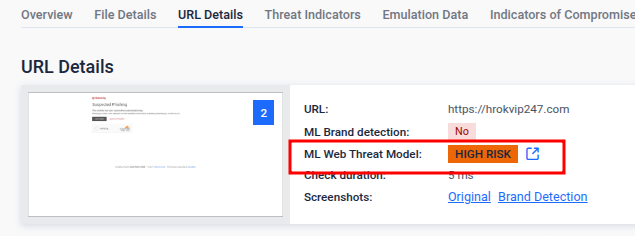MetaDefender Sandbox on-premise / standalone integrates with the following Web threat models
Introduction
The Web Threat Detection Model enhances security by analyzing a site’s structure, behavior, and content to label pages as malicious, based on sandbox verdicts. After gathering data, it makes predictions in milliseconds. It works in standalone environments but not in air-gapped systems.
Key Advantages Over Traditional Phishing Detection:
More Accurate Detection: Traditional phishing detection typically relies on URL reputation or known threat patterns, which can miss new or sophisticated attacks. This model checks multiple aspects of a site (structure, behavior, content), making it far more accurate at detecting threats.
Real-Time Evaluation: While traditional phishing detection often uses reputation data or blacklists, this model evaluates the site’s real-time behavior and content. This allows it to catch threats that don’t match known patterns or blacklisted URLs.
Faster Predictions: Predictions are made in milliseconds once the data is collected, ensuring quick threat identification compared to traditional methods, which can take longer due to live checks or scanning.
Operations
The model performs a comprehensive analysis on the collected data after sending a URL to the sandbox, including its structure, behavior, and content, to assess its safety, then generates a probability score indicating the likelihood of the URL being a web threat.
Report
Web threat result will be displayed under URL details tab in the scan report. Key: ML Web Threat Model
Confidence mappings
| Verdict | Description | Content model edges | Behavior model edges | Structure model edges |
|---|---|---|---|---|
| Trusted | Content and structure appear normal, with no threat indicators. | 0.0 - 0.2 | 0.0 - 0.2 | 0.0 - 0.1 |
| No Threat Detected | Slight or minor deviations detected, but overall low risk. | 0.2 – 0.35 | 0.2 – 0.35 | 0.1 – 0.2 |
| Undetermined | Ambiguous or atypical features; unable to determine threat confidently. | 0.35 – 0.6 | 0.35 – 0.5 | 0.2 – 0.8 |
| Low Risk | Moderate to strong indicators suggesting potential phishing behavior. | 0.6 – 0.8 | 0.5 – 0.75 | 0.8 – 0.88 |
| High Risk | Strong resemblance to known phishing patterns. High probability of being harmful. | 0.8 – 0.9 | 0.75 – 0.9 | 0.88 – 0.95 |
| Confirmed Threat | Overwhelming match to malicious signatures. Immediate mitigation recommended. | 0.9 – 1.0 | 0.9 – 1.0 | 0.95 – 1.0 |
Available on the product

Configuration
Currently, it runs by default on every URL scan and triggers notifications to consumers if the likelihood prediction exceeds a threshold.

